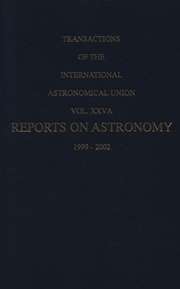No CrossRef data available.
Article contents
Working Group on Infrared Astronomy: (Groupe de Travail Pour L’Astronomie Infrarouge)
Published online by Cambridge University Press: 25 April 2016
Extract
In 1988, a Joint Commission (9 and 25) meeting on the causes of the well-known limitations on the precision of infrared astronomy led to several suggestions to improve matters (see Milone 1989). These included better reporting of the photometric systems in use by practitioners, redesign of the infrared passbands to be more optimally placed inside the atmospheric windows, and development of a method to ascertain the water vapor content of the atmosphere when the astronomical infrared measurements were being made. An Infrared Astronomy Working Group was formed to look into the matter. Advice and suggestions were solicited from the community at large. All who volunteered information became, de facto, members of the Working Group. A small subgroup composed of Andrew Young, Chris Stagg, and Milone set to work on the central of the recommendations: improvement of the passbands. Young, Milone, k Stagg (1994) (hereafter YMS) summarized the work: existing JHKLMN and Q infrared passbands were found to be both far from standardized, and all too frequently defined, to various degrees, by the water vapor and other components of the terrestrial atmosphere. Following extensive numerical simulations with a MODTRAN 3 terrestrial-atmospheres model package, and Kurucz stellar atmospheres, we suggested a set of improved infrared passbands designed explicitly to fit within, and not be defined by, the terrestrial atmospheric windows; however, we sought to optimize them so as to get the maximum throughput consistent with plausible limitations on precision of manufacture of the filters. In 1995 and again in 1997, a number of improvements were made in the code with which the improved passbands were designed. While they do not much affect the optimization trials and thus the passband recommendations, they have been used to extend the modeling.
Information
- Type
- Divisions and their Commissions
- Information
- Transactions of the International Astronomical Union , Volume 24 , Issue 1: Reports on Astronomy , 2000 , pp. 336 - 337
- Copyright
- Copyright © Astronomical Society of Pacific 2000

